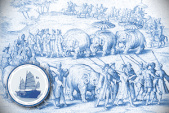II.3 The Bay of Bengal, Coromandel Coast, Ceilon

Consequently, the VOC and other European traders tried to monopolize the import of these two commodities textiles and opium by every means in the book – contracts, placards, trading passes, cruising vessels. In this way, the VOC strove to enforce its self-proclaimed trading monopoly. Despite this policy of containment, there was invariably an influx of ‘illegal’ opium and textiles. Old trading networks survived into the modern era despite Dutch efforts to destroy them.
Besides opium, the Europeans collected another important product in the port city of Chinsura (also known as Hooghly) at the mouth of the Ganges River: saltpetre or potassium nitrate (KNO3) which was used in the production of gunpowder.
The traders from the Coromandel Coast traditionally exported cotton textiles to Southeast Asia via the northern ports of Bheemunipatnam and Masulipatnam in the kingdom of Golconda. These ports were contested by the Dutch, French and British East India companies and declined in the second half of the eighteenth century.
Ceylon or Sri Lanka was linked culturally to the Coromandel Coast. The Dutch conquered the Portuguese-held ports of Negombo and Galle in 1640 and the main city of Colombo in 1656. They gradually expanded their power along the coastal areas. The inland Buddhist kingdom of Kandy remained nominally independentuntil 1766. The principal export products of Ceylon were elephants and cinnamon. Colombo was the second colonial city for the VOC in Asia after Batavia and both cities maintained strong ties with each other. Within the VOC network of empire, Ceylon served also as a place of banishment for various princes and noblemen from the Nusantara who had resisted the VOC. The Daily Journals still contain some letters from such banished aristocrats and popular leaders pleading to be sent back to their homelands.




